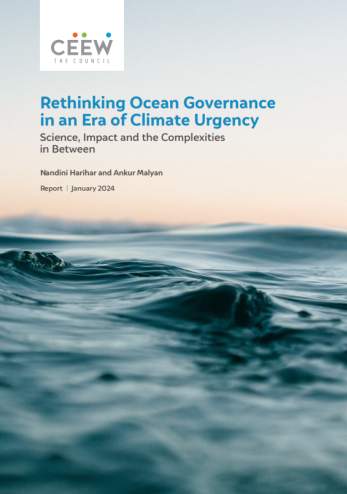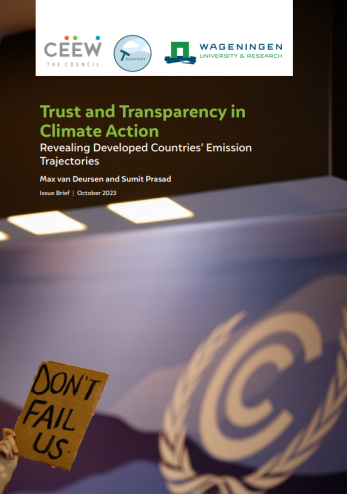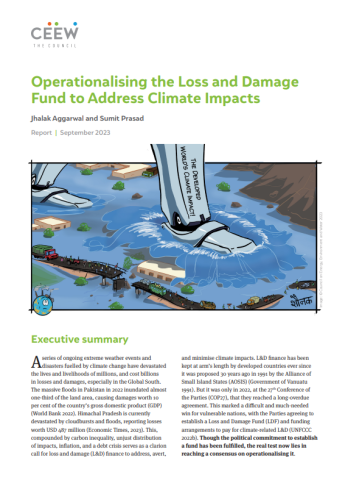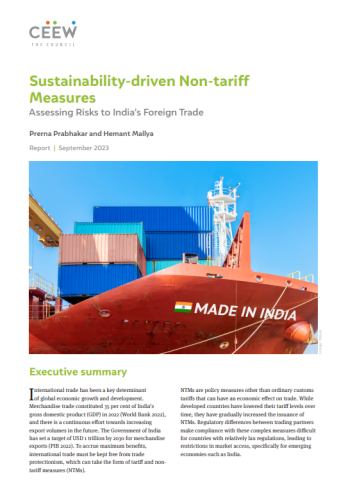



Suggested citation: Aggarwal, Jhalak, Nikita Shukla, Sumit Prasad, and Shikha Bhasin. 2022. Strengthening Climate Accountability: Improving Compliance and Delivery under the Paris Agreement. New Delhi: Council on Energy, Environment and Water.
Accountability is essential for global climate action and governance. The issue brief analyses the existing transparency and compliance mechanism under the Paris Agreement. Further, it discusses the challenges in ownership of targets and obligations under climate agreements amongst member countries.
Over the last few decades, governments have collectively made a series of pledges to combat climate change but limited progress has been made so far. The poor performance and accounting loopholes in the pre-2020 climate agreements still remain unaddressed under the Paris Agreement. To this end, the brief concludes by urging to strengthen accountability to improve compliance and delivery under the Paris Agreement.
Accountability is imperative in the current regime for global climate action. This is especially true at a time when after years of toil, the climate governance structure is still weak and current pledges are insufficient to adhere to science-based targets for limiting temperature rise to below 1.5°C to 2°C. This issue brief discusses the concerns surrounding the actual implementation of climate action, enforcement of or adherence to the obligations of climate agreements, and accountability of the consequences of noncompliance. It also highlights how these elements neglected in the pre-2020 climate agreements still remain unaddressed in the Paris Agreement. Finally, it urges strengthening of compliance mechanisms in the Paris Agreement and recommends strategies that could lead to enhanced accountability of member countries.
The climate crisis is causing heatwaves and floods across the globe, impacting our economy, health, and natural ecosystems at large (IPCC 2022). With increasing fossil fuel emissions as well as record high greenhouse gas (GHG) concentrations, we are certainly heading in the wrong direction (UN 2022). Moreover, the science is clear on the need for more ambitious climate actions to reduce global temperatures and avoid a climate catastrophe.
The member nations to the United Nations Framework Convention on Climate Change (UNFCCC) have deliberated on climate change, its recognition, ambition, commitments, and delivery for almost three decades. It began with the acknowledgment of the issue and the entering into force of the UNFCCC on 21 March 1994. The UNFCCC aims to prevent ‘dangerous’ human interference with the climate system. The Convention puts the onus on developed countries to reduce emissions and suggests that they support and uphold developing countries in their climate efforts and actions, inter alia, captured in the rule of common but differentiated responsibilities and respective capabilities (CBDR-RC).
To operationalise the principles of the Convention, member states negotiated and adopted the Kyoto Protocol (1997) and its Doha Amendment (2012). Both these climate agreements set legally binding targets on developed countries. The Kyoto Protocol sets a collective emissions reduction target of 5 per cent on 1990 levels for the period 2008–2012, whereas the Doha Amendment sets a reduction target of 18 per cent on 1990 levels for the period 2013–2020 (UNFCCC 1998, 2012). Although both the climate agreements were expected to establish a strong foundation for the fight against climate change, there were major setbacks and concerns surrounding their implementation.
Developed countries performed half-heartedly. The United States, the second-largest emitter, decided not to ratify its commitments under the agreement.
Canada’s national emissions increased by 30 per cent instead of decreasing by 6 per cent from 1990 levels (Curry and McCarthy 2011). Canada also withdrew from the Kyoto regime to avoid paying billions of dollars as a non-compliance penalty (FT 2011). Owing to the United States’ non-participation, Japan also quit from the climate agreements. To further add to the woes, the Russian Federation and New Zealand refused to accept the new targets under the Doha Amendment. Due to these issues, the Doha Amendment to the Kyoto Protocol did not come into force for almost its entire duration (Prasad, Pandey, and Bhasin 2021).
The Intergovernmental Panel on Climate Change (IPCC) report further indicates that the mitigation efforts undertaken by developed nations under the Kyoto Protocol were insufficient (Intergovernmental Panel on Climate Change 2007). The targets set under the Doha Amendment, despite being on the higher end, were also inadequate to limit the global temperature rise. None of the developed countries made efforts to strengthen their commitments or revise their pledges despite being encouraged by the IPCC’s fourth assessment report to enhance their targets by at least 25 to 40 per cent below the 1990 levels by 2020.
In an earlier study by CEEW, it was estimated that developed nations emitted around 25 GtCO2eq (carbon dioxide equivalent) more than their estimated emission allowances1 in 2008–2020 because of nonparticipation in climate agreements and misuse of accounting provisions (Prasad, Pandey, and Bhasin 2021). With regard to providing support to developing and least-developed countries, the climate finance goal commitment2 of 100 billion US dollars by 2020 was never met (Timperley 2021). The decision text of the Glasgow Climate Pact also expressed deep regret that this financial goal was not met (UNFCCC 2021a). In sum, the performance of developed countries in the pre-2020 climate regime is characterised by delivery gaps in action and support, misuse of accounting provisions,3 non-alignment of commitments with science, and easy exit from or non-participation in climate agreements without any punitive consequences. This showcases how vulnerable international climate governance is. In particular, it shows a lack of accountability and enforcement mechanisms.
In light of the looming climate crisis, accountability and enforcement mechanisms are issues that we can no longer ignore but are matters of grave concern that must be addressed as we move ahead towards implementing the Paris Agreement. This issue brief explores mechanisms to strengthen the enforcement of and accountability for climate actions under the Paris Agreement. The aim is to initiate a discussion on how and where we can plug in accountability – the missing piece in the debate surrounding climate negotiations. Section II provides an overview of the existing transparency and compliance mechanisms under the Paris Agreement. This is followed by Section III, which maps the key limitations and challenges of current transparency and compliance mechanisms under the Paris Agreement. The brief concludes in Section IV by outlining recommendations to strengthen accountability and deal with non-compliance under the Paris Agreement through novel means.
At the twenty-first Conference of Parties,4 countries agreed on a new global climate deal, the Paris Agreement, to combat global climate change. The Paris Agreement was a monumental step because it brought all nations together to undertake ambitious climate efforts, adapt to climate impacts, and enhance support to assist developing countries. The Paris Agreement is a legally binding agreement,5 which sets out a global framework to limit global temperature rise to 2°C within this century, and preferably 1.5°C, if possible. However, the success of the Paris Agreement depends on ensuring compliance and enforcing accountability (Climate Law and Governance Initiative 2022).
The following features of the Paris Agreement relate to accountability and compliance:
Unlike the Kyoto Protocol or Doha Amendment, where the targets were incorporated in an annex to the agreement, the Paris Agreement obligates countries to “undertake and communicate ambitious efforts” in the form of NDCs to achieve the goals of the agreement. These commitments should be made every five years to reflect a country’s highest possible ambition and should represent a progression of ambition from previous NDCs. Countries are also encouraged to prepare their longterm strategies (mid-century) on how they are planning their transitions towards low GHG emissions or net zero, taking in account national circumstances and bestavailable science.
One of the central components of the Paris Agreement is the ETF, which builds on the existing transparency mechanism and adds credibility to member states’ efforts to implement climate actions. The ETF guidelines offer a common approach to the reporting and review process, but with flexibilities for developing countries (linked to their capacity constraints). The ETF supersedes the existing transparency arrangements and demands that all countries report more granular data than before on their GHG emissions along with progress in implementing NDCs, adaptation measures and efforts, and the support (financial, technological, and capacity-building) needed, received, and/or provided to developing countries (UNFCCC 2019a). Under the ETF provisions, all countries6 are required to submit biennial transparency reports (BTRs)7 and the national GHG inventory, which are subject to a technical expert review8 and facilitative, multilateral consideration of progress (FMCP).9 Both the review and FMCP processes allow for independent assessments of a country’s progress in implementing its NDC. Furthermore, reporting under Article 9.5 of the Paris Agreement demands information on ex-ante climate finance every two years from developed nations and encourages developing nations to follow suit. These submissions function as formal sources of progressive finance information, making them crucial for planning and enhancing ambition.
The GST process is one of the fundamental components of the Paris Agreement. It helps nations monitor the implementation of the Paris Agreement and evaluate the collective progress made towards achieving longterm climate goals. The first GST will take place in 2023 and every five years thereafter. It will be based on the best-available science and inform member countries on updating and enhancing their NDCs to achieve their climate objectives.
Article 15 of the Paris Agreement establishes an expert-based committee to facilitate implementation and promote compliance with the provisions of the Agreement. The committee’s mandate is to engage with Parties to identify challenges, share information, and make recommendations, including in relation to accessing finance, technology, and capacity-building support. The committee acts on circumstances related to assistance requested by countries, non-participation of a country in Paris Agreement processes, and failure to submit reporting obligations or commitments.
The Paris Agreement is an exemplary case of international cooperation because it unites almost all the nations of the world to address the critical issue of climate change. The agreement, with its unique architecture, aims to strike a balance between the participation of countries and their commitment. However, the larger question on delivery (actual implementation), enforcement (adherence to climate agreement obligations), and accountability (acceptance of consequences on non-compliance) still remains unaddressed.
The first reason is the absence of in-depth clarity, transparency, and understanding of the targets (NDCs or the net-zero commitments). An Organization for Economic Co-operation and Development (OECD) study highlights that the net-zero targets are misleading as some exclude specific GHGs or have not clearly stated the target’s scope (OECD 2022). CEEW analysis further suggests that only 26 per cent of nations report on all seven gases in NDCs and only 40 per cent have announced their net-zero targets formally.10 In the absence of clearly defined targets and given fragmented information, it becomes difficult to understand the progress made and obtain a true picture of climate actions.
Second, climate action and pledges are inadequate. The latest analysis shows that with collective national climate pledges, we are on track to experience a global temperature rise of 2.7°C – 3.3°C by the end of the century (United Nations Environment Programme 2021). The pledges also lack critical features such as ensuring timely communication of successive NDCs and alignment with science-based targets. Hence, there is little opportunity for holding countries accountable for their unambitious climate pledges. In addition, NDCs, in principle, are mitigation-centric, because adaptation, loss and damage, and support do not directly fall within their purview. With rising extreme weather events and escalating risks and impacts, NDCs must capture actions and measures across all areas, including loss and damage. As of August 2022, merely 34 per cent of NDCs mention loss and damage, and most of this is by Latin American countries owing to their climate vulnerabilities.
Third, easy exit from the Agreement in the absence of penalisation mechanisms is a major loophole. Although there are some instances where civil society and individual and other stakeholders do put pressure on member states, through domestic courts or even, potentially, international courts and tribunals, to comply with obligations, the efforts appear to be ineffective to a large extent. For example, the United States, the world’s second-largest emitter, did not participate in any pre-2020 climate agreements and also withdrew from the Paris Agreement in 2020 (McGrath 2020) while joining back in 2021. Such easy exits, in the absence of harsh penalties and punitive actions, not only undermine global climate cooperation and result in additional burden on other nations, but they also discourage other nations from undertaking ambitious targets to move closer to the Paris deal.
Finally, the Paris Agreement is based on facilitative, non-intrusive, and non-punitive principles.11 Although these principles ensured countries’ participation, it can be clearly seen that countries are not subjected to any hard measures. Furthermore, compliance under the Paris Agreement is limited to procedural obligations – meaning the submission of reports and enhanced commitment – and does not necessarily cover actual outcomes related to the delivery of climate actions (Climate Law and Governance Initiative 2022).
Based on the experiences from the pre-2020 climate regime, as well as the limitations of the Paris Agreement, we conclude that the prospects for delivery of climate action, enforcement of obligations, and accountability are slim. The Paris Agreement imposes no hard enforcement measures to hold member countries liable for their inaction and non-compliance with the Paris provisions. This clearly highlights the urgent need to deliberate on strengthening accountability mechanisms, which would ensure compliance with obligations and also translate ambition to real action (delivery).
We describe here some key recommendations to strengthen accountability.
Article 15 of the Paris Agreement establishes a Paris Agreement Implementation and Compliance Committee (UNFCCC 2019b) to facilitate implementation and promote compliance with the provisions of the Agreement. However, the mandate of the Compliance Committee is extremely broad; it primarily engages in dialogue and assists member states in developing their action plans but does not function as an enforcement or dispute settlement mechanism (UNFCCC 2019c). Since this does not define any concrete implications in case of non-compliance with provisions, we recommend that the scope of the committee be enhanced, with clear guidelines for its functioning as an enforcement mechanism in cases of non-compliance. This could be in the form of:
If compliance measures are not enhanced, there would be little incentive for nations to adhere to the Agreement and the larger climate objective.
Non-party stakeholders12 are critical pillars of climate negotiations in terms of strengthening accountability. Several civil society initiatives across the globe are supporting member states in adhering to climate obligations, delivery of domestic climate actions, and identification of critical challenges; they are also bridging transparency gaps. These roles of non-party stakeholders should be formalised within the provisions of the Paris Agreement. It could be in the form of acknowledgment (or consideration) of independent assessment by non-party stakeholders or related collective bodies (e.g., research and independent NGOs) of the country’s performance during its review of the BTRs. The in-depth knowledge of non-party stakeholders could further support member states by providing more nuanced clarity, transparency, and understanding of the commitment. Media could further scrutinise how nations are turning their targets into reality, based on credible facts and data ensuring public accountability of the climate promises and pressure for action. Furthermore, participation of non-party stakeholders in the GST process could be strengthened by having provisions that would support or encourage their role in providing critical inputs and analysis during the technical phase of the GST.
Climate legislation is a cross-sectoral, regulatory instrument that lays down the guidelines, defines the institutional framework for policy implementation, and highlights interim targets with clear timelines (NRGSD 2010). Recently, Australia passed a new law – the Climate Change Bill – enshrining the climate pledge in domestic law as a step to end a decade of climate inaction (BBC 2022). We recommend that nations draft domestic laws to include climate targets with clear guidelines, unbundling responsibilities across tiers of government and strengthening accountability. The law should ensure integration of different climate bodies under one holistic national climate law and highlight the role of sub-national jurisdictions in incorporating climate-friendly policies, regulations, and investment decisions. This can ensure transparency and accountability for progress, with the main incentive for compliance being the threat of judicial review.
Climate cases are considered to be some of the most complicated cases in climate litigation because they require establishing a number of links that are not obvious and are open to challenges depending on the kind of study used and its interpretation by the court (Watson 2022). An Oxford-led team assessed 73 lawsuits and indicated that the climate evidence used by lawyers commonly lagged behind the latest science and information available, which could have helped in establishing causal links (Stuart-Smith et al. 2021). This is where attribution science steps in and can help establish this causal relationship. Better availability and accessibility of attribution studies can establish the link between emissions and impact, providing a powerful means for everyone, everywhere to strengthen climate lawsuits and hold poor performers directly responsible. Hence, climate cases challenging inaction or lack of climate ambition can promote the ambitions set under the Paris Agreement and encourage actors to pursue stronger climate actions globally.
Notes
1 Estimated emission allowance refers to the total allocation of carbon space to developed countries based on their assigned target under the Kyoto Protocol and its Doha Amendment.
2 Decision 3/CP.19.
3 Using accounting provisions to set a higher baseline for emissions, leading to additional carbon credits.
4 Conference of Parties is the annual climate conference.
5 Limited towards procedural obligations of the Paris Agreement: for example, submission of reports communicating NDCs is legally binding, but the actual outcomes related to the delivery of climate actions are not legally binding.
6 Conference of Parties is the annual climate conference.
7 BTRs are formal communications under the Paris Agreement that developed and developing nations need to submit every two years to the UNFCCC Secretariat.
8 Technical expert review is a process to provide a comprehensive and technical assessment of a party’s implementation of its commitments.
9 Under this process, the parties must undergo a state-to-state review process under the Paris Agreement’s ETF, which centres on progress on NDCs as well as obligations related to the support provided to developing country parties.
10 The seven gases are CO2, CH4, N2O, HFCs, PFCs, SF6 and NF3.
11 Based on Article 13 of the Paris Agreement.
12 International organisations, civil society, academic institutions, media and businesses.

Rethinking Ocean Governance in an Era of Climate Urgency

Trust and Transparency in Climate Action

Operationalising the Loss and Damage Fund to Address Climate Impacts

Sustainability-driven Non-tariff Measures